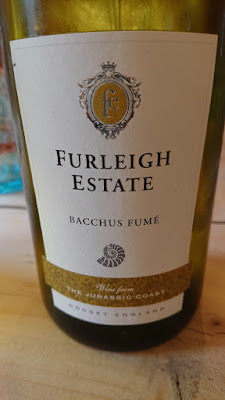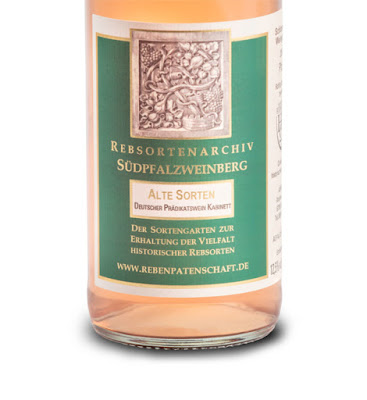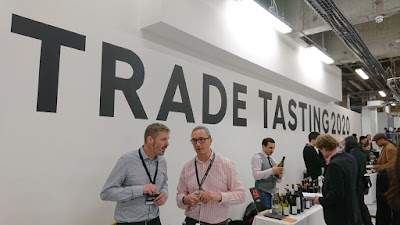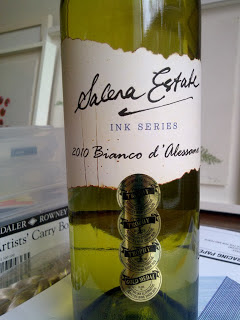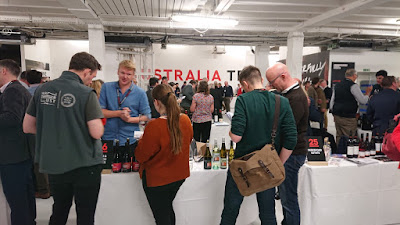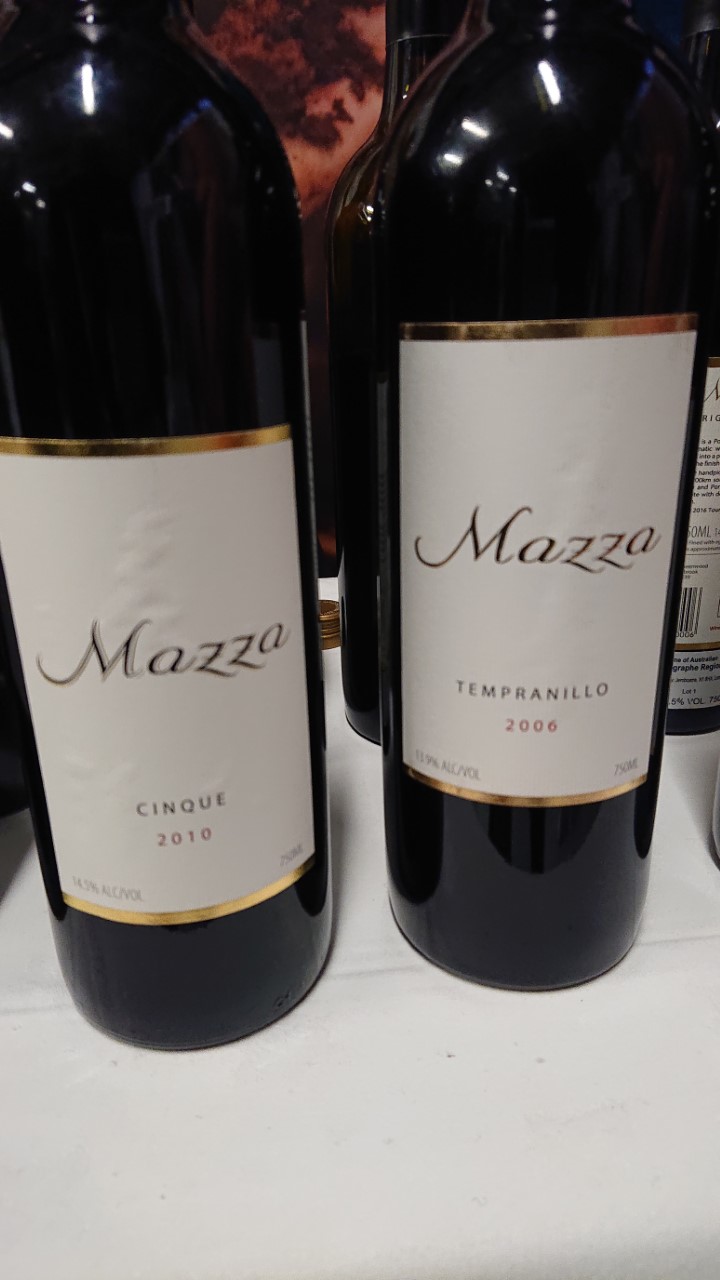The Australia Trade Tasting 2020 was our chance to find out how the horrendous forest fires had been affecting vineyards. From what we could gather New South Wales and Victoria have been the worst hit but real facts thus far were somehow hard to come by possibly because they won't be fully known until this year's and next year's vintage has been made.
We had always missed the Australia tasting somehow so it was doubly important to get down to B1, the basement in Victoria House, Southampton Row, Holborn, London where the tasting was taking place (it's just over the road from where Sir John Barbirolli was born - everyone knows where that is of course).
In the entrance our concerns were immediately addressed by a leaflet entitled 'Bushfire Update.' In this we read that
'the start of 2020 has been a difficult one. People have lost their lives, their homes, pets and livestock - and our wildlife ecosystems have been dramatically affected.'
But also
'The wine sector has been very fortunate that the losses to date have been limited'...
'Around 1 per cent of Australia's vineyards are in areas affected by fires. Fortunately not all vineyards in these areas are fire damaged.'
That is good news. The season is far from over however and worse may be to come but for the moment we can cross fingers and buy Australian wine as the best way of helping out.
 |
| the great man himself, Darby Higgs. |
The Slotovino relationship with Australian wine is the closest of any of ours in the southern hemisphere. This is partly due to a wonderful person, Darby Higgs. Darby has been devoted to diversity, Australian diversity in particular longer than anybody. His site is calld VinoDiversity and is described as
the only website solely about Australian wines made from alternative grape varieties of which there are over 100 described on the site. Argentina, Brazil, Chile, Namibia, New Zealand, Peru, South Africa, Uruguay, Zimbabwe - are you listening?
We had the pleasure of meeting the great man a few years ago in Melbourne and he gave us a really wonderful bottle: a Bianco D'Alessano from Salena Estates in South Australia.
 |
| John Thorne of Portal, Dingwall and Norris |
Our enthusiasm for this example of Bianco D'Alessano was such that we imported a case thanks to John Thorne who persuaded Fells agencies to put the wine with one of their shipments from Australia to the UK. John has earned our eternal gratitude ever since and indeed it was he who prompted us to come to the Australian Trade Tasting this year.
So it was with justified expectancy that we entered B1 - we were not disappointed. Of course there were no unique varities although Australia has been active in producing new ones such as Tarrango, Cygne, Cienna, Rubienne, Taminga and so forth. Nevertheless the diversity was impressive. Here are just a few of the varieties that appeared on the labels;
Brachetto
Cabernet Franc
Cabernet Sauvignon
Chardonnay
Chenin Blanc
Glera
Graciano
Grenache
Gruener Veltliner
Kerner
Malbec
Mataro/Mourvedre
Nebbiolo
Pedro Jimenez
Petit Manseng
Pinot Meunier
Pinot Noir
Rousanne
Sagrantino
Sangiovese
Sauvignon Blanc
Sciacarello
Saperavi
Semillon
Shiraz
Sousão
Tempranillo,
Tinta Cão,
Touriga Nacional
Viognier
We thought that was pretty good.
The actual wines were also pretty good; there were none that fell below a certain standard. All were pleasant to drink and some of course were exceptional.
In a break with our usual format we're just going to add labels to the above.
But before we do here's a quick roundup of two of the more interesting blends:
Mazza Wine's 'Cinque' is a blend of Graciano, Tempranillo, Tinta Cão, Touriga Nacional and Sousão. Mazza seemed right away to be our kind of producer. Quoting from their website:
Anne and David Mazza specialise in growing Spanish and Portuguese
varieties on a small, family-run vineyard in the Geographe Region, near
Donnybrook, 200km south of Perth, Western Australia.
Our Story
In 2002, we planted six red grape varieties - Bastardo,
Graciano, Tempranillo, Tinta Cão, Touriga Nacional, and Sousão. From
these we produce a unique Bastardo rosé, a range of straight varietal
red wines and delicious blends like our Cinque - The Five. We also
produce fortified wines....
Our plantings have been inspired by our travels through Spain
and Portugal and the fantastic wines of Rioja and the Douro Valley. We
are proud to produce an Australian translation of these Old World
heritage varieties and believe we are the only Australian vineyard to
present this collection from a single site. We look forward to planting
other interesting grapes in the not too distant future.
and
Koerner have gone with Sangiovese, Grenache, Sciacarello and Malbec.
They are another producer who immediately struck us as on our wavelength. They even have some Mammolo. Koerner describe themselves thus;
We are the Koerner brothers. 2019 Young Gun of Wine Award winners and wine lovers from way back. Our wines are produced from fruit grown in Watervale, Clare Valley,
with the majority of our grapes coming from the Koerner family vineyard,
Gullyview. With a focus on fruit quality and transparent winemaking, our wines
are textural and approachable, light, fresh, and ultimately drinkable. We hope you enjoy them as much as we do.
Damon and Jono Koerner
So now to some of the monovarietals:
Brachetto
Pizzini have been on our radar for many years. They are not just Italian orientated, they are Italian full stop. As well as the usual Italian grapes (lots of Glera/Prosecco, Pinot Grigio, Nebbiolo, Sangiovese) they grow Arneis, Verdicchio, Verduzzo, Barbera, Canaiolo, Sagrantino, Teroldego and this Brachetto. Bravi.
Chenin Blanc
We hadn't associated Australia with Chenin Blanc but why not?
Glera
As well as Pizzini mentioned above, others seem to have mounted the Prosecco bandwagon. We didn't taste this one from Alpha Box and Dice. Another estate whose website is worth quoting;
Based in McLaren Vale, South Australia, Alpha Box & Dice are
embarking on an Alphabet of Wine. Each 'letter' embodies an individual
winemaking project, with the end goal being a complete collection of
wines that celebrates the diverse styles and varieties found in South
Australia's famous wine regions, including McLaren Vale, Adelaide Hills
and Barossa Valley. Since its beginning in 2008, AB&D has become a
champion of South Australia's alternative – particularly Mediterranean –
varieties, exhibiting innovation at every step of the process by
bending tr, aditional winemaking norms.
Surprising varieties include Aglianico, Dolcetto, Montepulciano, Nero D'Avola and Tourigas Nacional and Roriz.
Grenache
Good to see Kiikanoon repersented here by a Riesling (see below) and this Grenache among others. Their 100 year old port was unaccountably not on offer for tasting.
Gruener Veltliner
Tomich was not the only estate producing Gruener Veltliner. Australia seems to be sensitive to world trends all right.
Kerner
This was a surprise but then Kerner has a niche in the Alto Adige so why not also in the Eden Valley? Kontrapunkt Kerner is made by Chaffey Bros. From Fechner grapes. Chaffey Bros' website:
100% Kerner (A.K.A. Weißer Herold) from the revered Fechner Bros’
vineyard in the Northern Eden Valley. The Kerner grape is a 1929
cross-breed of Riesling and Vernatsch. Graeme and Michael Fechner
brought cuttings to their Eden Valley vineyard in 2001 following a
research trip to Germany.
In the last few years we have incorporated the Fechner Bros’ Kerner
into our aromatic blend “Düfte Punkt”, cofermenting it with Riesling and
Gewürztraminer from the same vineyard. “Kontrapunkt” however is the
first wine we have made solely out of Kerner grapes and is Australia’s
only varietal Kerner!.
Mataro/Mourvedre
We include Mataro here not because it is rare in Australia (quite the opposite) but because we love it.
Nebbiolo
Nebbiolo seems to be on the up in Oz.
Pedro Jimenez
This was an exquisite desert wine by Turkey Flat. It belongs to our Mmmmm category.
Petit Manseng
Zoe and Rollo Crittenden don't say it on the Hispanic style label but this is Petit Manseng - a grape of which we thoroughly approve. Daughter and son of the famous Gary Crittenden of the Mornington Penisula they refer on the back label to having fallen foul of EU regulations in the first name given to this wine, but what could that have been? Petit Manseng is at home in Jurancon, near but not in Spain.
Riesling
Roussanne
Lobenthal Road is in the Adelaide Hills. As well as all the usual varieties found in Australia they have this Roussanne and Tempranillo.
Sagrantino
Another surprise; Sagrantino is made by more than Pizzini (see above). This one is from Oliver's Tarango Vineyard in MacLaren Vale. Sagrantino from its home in Umbria can be hard to love. Australian versions may be more approachable.
Tempranillo
Two versions of Tempranillo by Pizzini. Quite a few other producers are working with this grape now in Australia. That fact was one of the many brought to us by this show.
Sangiovese
Saperavi
We had first heard of Australian Saperavi when coming across Domaine Day years ago. Nice to see there are others producing a monovarietal Saperavi as this one by Patritti.
Semillon
 |
| Mount Horrocks, Clare Valley |
 |
| Keith Tulloch, Hunter Valley |
 |
| 3 different Semillons from Gundog Estate, Hunter Valley |
 |
| David Franz's Long Gully Rd. Ancient Vines, Barossa Valley 12.8% |
We have just read that the great and venerable McWilliams producer has just gone into receivership. Perhaps that is why their iconic Mount Pleasant Elizabeth has until recently been available at markedly low prices and a sparkling Semillon of theirs could be bought from Sainsburys for under £7 not so long ago - the bargain of the century for sure. We very much hope that the estate will be taken over by new sympathetic owners who will continue to make these great wines.
 |
| A Margaret River Semillon. |
No apologies about featuring Semillon in particular in this blog. Here are some interesting facts about this variety;
At the start of grape growing in Australia, Semillon was the most widely planted variety.
It is still made in various regions including the Hunter Valley, Barossa Valley, Clare Valley and Margaret River.
Each of these regions produces a Semillon of different character with alcohol levels varying from 10% - 13.5%
In the Hunter Valley at least, Semillon never sees wood but the wine nonetheless has the taste of having been in barrel.
In our experience Semillon is the last to spoil. Somehow, it remains fresh even when oxydised to some extent.
Maybe this is a by-product of its being incredibly age-worthy; the longer you keep it the better it is.
It comes in both dry and of course sweet versions (think sweet Bordeaux). There are even very successful sparkling examples.
Auberon Waugh wasn't keen on it.
Shiraz
Can't mention Australian wine without mentioning Shiraz. Major Kong is available from Bottle Apostle.
Tempranillo
 |
| Mazza again. |
 |
| Tempranillo with some Viognier. |
Tempranillo a-plenty.
Touriga Nacional
Only slightly less plentiful than Tempranillo.
Vermentino/Pigato
Vermentino is called Pigato in Emilia Romagna. Koerner again. Good on yer!
So plenty of Australian wine here that you can buy and help Australia in their worst ever natural disaster at the same time. Diverse, interesting, original -
so where the bloody hell are you? to coin a phrase.









